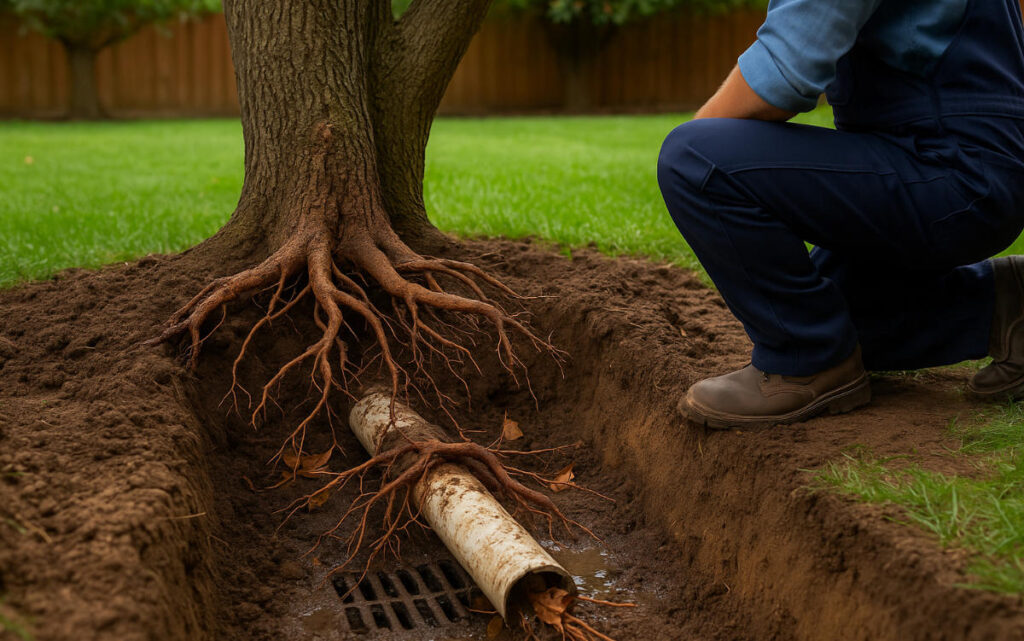If you’ve ever had a slow drain that just wouldn’t clear, there’s a good chance the culprit wasn’t inside your home at all. Tree roots are one of the most common causes of stubborn drain problems in the Seattle Metropolitan area, and they don’t give up easily.

Roots are strong, persistent, and always on the hunt for moisture. Unfortunately, your underground sewer and drain lines make the perfect target. Let’s take a closer look at how roots invade drains and, more importantly, what you can do about it before it turns into a plumbing emergency.
How Tree Roots Sneak Into Drains
It’s amazing how something as small as a hairline crack in a pipe can invite trouble. Tree roots naturally grow toward moisture, and when they detect vapor or water escaping from tiny pipe openings, they slip inside. Once inside, the roots expand and multiply.
Over time, these fine root hairs turn into thick tangles that clog your pipes completely. The process may take years, but by the time you notice slow drains or frequent clogs, the problem is often advanced. Older homes in Seattle are particularly vulnerable since many still rely on clay or concrete sewer lines, which are more prone to cracks and leaks than modern PVC piping.
This slow invasion is why regular drain cleaning and inspection are so important. Catching root growth early can save you from expensive repairs down the road.
Signs That Roots May Be the Problem
Tree root invasions aren’t always obvious right away. The signs can look a lot like ordinary drain clogs, which is why many homeowners don’t realize what’s happening until it’s serious.
Common red flags include:
- Repeated drain clogs in different fixtures around your home.
- Gurgling sounds from toilets or sinks.
- Sewage smells near drains or in the yard.
- Wet spots, sinkholes, or unusually green patches of grass in your lawn.
- Backups that occur more often after heavy rain.
If you’re dealing with these issues, roots could be to blame. Unlike regular clogs caused by grease or debris, root-related blockages won’t clear up with store-bought cleaners. That’s where rooter services or hydro jetting come into play.
Professional Rooter Services
Rooter services are often the first line of defense against tree root blockages. A rooter machine uses a rotating cable fitted with blades to cut through roots and restore flow. Think of it as giving your drain line a haircut, trimming back the invading roots so wastewater can move freely again.
This method provides quick relief, but it isn’t always permanent. Roots can grow back through the same cracks unless the pipe is repaired or replaced. Still, rooter services are an effective and affordable way to handle the immediate problem, especially if you need fast relief from a clogged line.
For many homeowners, rooter services act as a bridge between discovering a root invasion and planning for a long-term solution like pipe lining or replacement.
Hydro Jetting for Stubborn Root Problems
When roots are especially dense or the clog is severe, hydro jetting is often the best solution. This technique uses a high-pressure stream of water to blast roots, grease, and debris out of your pipes. It’s like power washing your sewer line from the inside.
Benefits of hydro jetting include:
- Clears stubborn clogs more thoroughly than rooter machines.
- Removes grease and buildup that encourage future root growth.
- Restores pipe diameter for better water flow.
- Environmentally friendly since it doesn’t rely on harsh chemicals.
Because it scours the pipe walls clean, hydro jetting not only eliminates roots but also prevents them from regrowing as quickly. It’s a powerful service offered by many Seattle plumbers, often paired with camera inspections to make sure the line is completely clear.
Repairing or Replacing Damaged Pipes
Cutting or flushing roots out is only part of the solution. If your drain line is cracked or leaking, it’s essentially an open invitation for roots to come back. That’s why repair or replacement is often recommended after a severe invasion.
Depending on the extent of the damage, your options might include pipe lining, pipe bursting, or full replacement. Pipe lining involves coating the inside of the damaged pipe with a resin that hardens into a smooth, root-resistant surface. Pipe bursting pulls a new pipe through the old one, breaking the damaged pipe apart as it goes. Both methods are less invasive than traditional trench digging, which can tear up your lawn or driveway.
Working with licensed plumbers ensures the job is done right and complies with Seattle building codes.
Preventing Future Root Invasions
Once you’ve dealt with roots, prevention becomes the top priority. No one wants to face the same issue again in a few years. Luckily, there are steps you can take to discourage root growth.
Prevention strategies include:
- Scheduling routine drain cleaning services every 1-2 years.
- Avoiding planting trees or shrubs near sewer lines.
- Using slow-release root-killing treatments recommended by plumbing professionals.
- Replacing old clay or cast-iron pipes with modern PVC piping.
Preventative maintenance may not sound exciting, but it’s far cheaper and less stressful than dealing with a full-blown root invasion. A little planning now saves a lot of headaches later.
The Role of Sewer Camera Inspections
One of the most effective tools in diagnosing and preventing root problems is a sewer camera inspection. This involves feeding a waterproof camera through your sewer line to get a live look at what’s happening inside.
Camera inspections let plumbers confirm if roots are the cause of clogs, determine how severe the invasion is, and plan the best course of action. They’re also invaluable after a cleaning service to make sure the line is completely clear.
For homeowners in the Seattle Metropolitan area, camera inspections can be the difference between catching a problem early and waiting until it becomes an emergency plumbing call.
Why DIY Solutions Don’t Work
Some homeowners try to tackle root problems with chemical drain cleaners or homemade remedies. While these might offer temporary relief for minor clogs, they rarely work against tree roots. In fact, harsh chemicals can corrode older pipes, making them even more vulnerable to root intrusion.
Professional drain cleaning is the safest and most effective solution. With tools like hydro jetting, rooter machines, and camera inspections, trained plumbers can eliminate the problem without causing further damage. DIY solutions often buy a little time but don’t address the root cause (literally).
Tree Roots Invading Your Plumbing? Call Gene Johnson Today for Professional Rooter Solutions!
If you’ve noticed slow drains, gurgling toilets, or recurring clogs, don’t wait until it becomes a full-blown plumbing emergency. Tree roots can cause serious damage to your sewer line, but with the right help, you can stop them in their tracks.
At Gene Johnson Plumbing, Heating, Cooling, and Electrical, our drain specialists know how to handle root invasions the right way. From rooter services and hydro jetting to long-term pipe repair, we provide effective solutions tailored to your home. Call us today at 206.792.7495 to schedule professional drain cleaning services and protect your plumbing from future root trouble.





